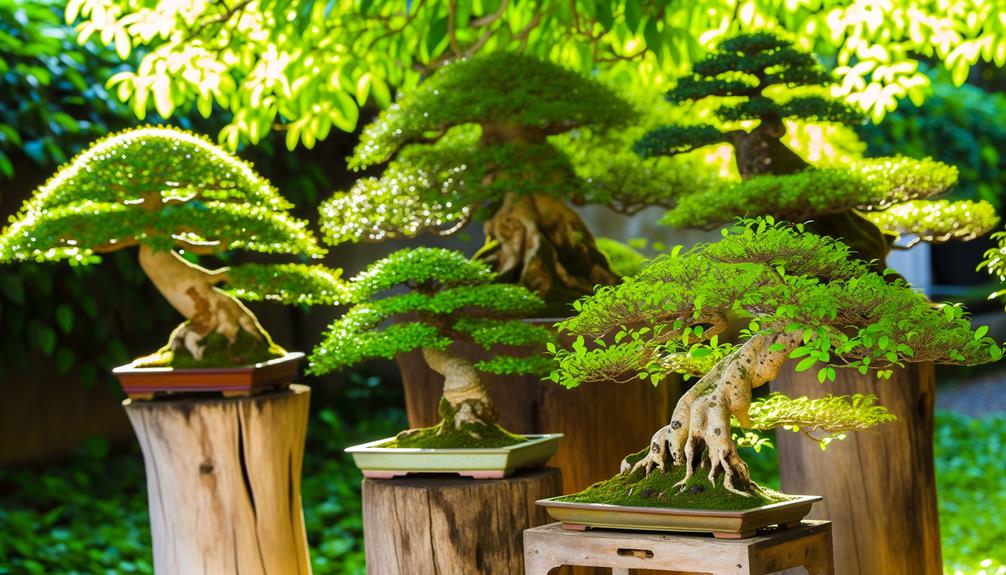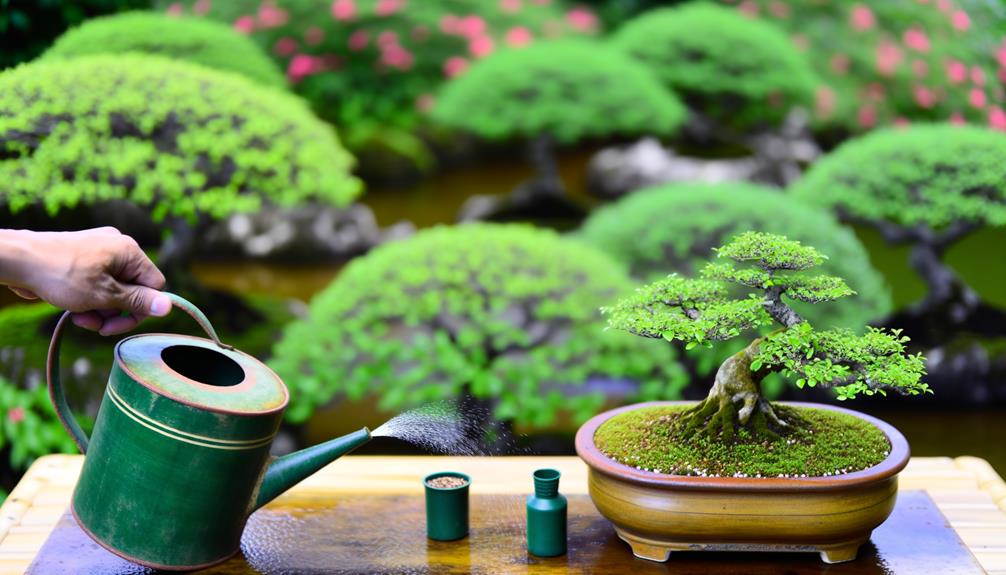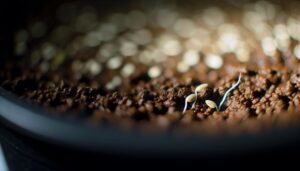5 Steps to Successfully Grow Your Own Bonsai Plants
Cultivating bonsai plants involves selecting appropriate species based on environmental requirements, leaf morphology, and climatic conditions. Necessary tools include precision pruning instruments and nutrient-rich, well-draining soil.
Shallow containers support root pruning and dwarf stature while ensuring structural stability. Mastery of pruning and shaping techniques, using concave cutters and wires, is vital for managing apical dominance and achieving aesthetic forms.
Seasonal care, such as spring repotting, summer hydration, autumn fertilization adjustments, and winter frost protection, maintains bonsai health. For detailed guidelines on each aspect, including specific seasonal regimes and advanced shaping methods, further information is outlined.

Key Takeaways
- Select a bonsai species suited to your climate, considering its environmental requirements.
- Use precision pruning tools to maintain shape and health, focusing on managing apical dominance.
- Prepare a well-draining, nutrient-rich soil mix and choose a shallow container for root health.
- Apply wiring techniques carefully, using anodized aluminum or annealed copper wire for shaping.
- Tailor care practices to the season, including repotting in spring and frost protection in winter.
Choosing the Right Species

Selecting the appropriate bonsai species is vital, as it involves understanding the specific environmental requirements, growth patterns, and maintenance needs of various plant types.
Deciduous species, such as Acer palmatum (Japanese Maple), require seasonal climate variations and thrive in temperate zones.
Coniferous species like Pinus thunbergii (Japanese Black Pine) demand well-draining soil and full sunlight exposure.
Tropical species, including Ficus retusa (Ginseng Ficus), necessitate consistent warmth and humidity levels.
Each species presents unique challenges; for instance, Juniperus procumbens (Green Mound Juniper) requires diligent pruning to maintain its form.
The physiological characteristics, including leaf morphology and root structure, must be considered to ensure optimal health. Understanding these variables is essential for the successful cultivation of bonsai.
Essential Tools and Supplies
To cultivate a thriving bonsai, it is imperative to utilize precision pruning and shaping tools, including concave cutters, shears, and wire.
The selection of appropriate soil, rich in nutrients and with adequate drainage properties, is equally critical to sustain the plant's health.
Additionally, choosing the right container, which provides stability and complements the tree's aesthetic, plays a pivotal role in the overall success of bonsai cultivation.
Pruning and Shaping Tools
A profound understanding of pruning and shaping tools is vital for the meticulous care and aesthetic refinement of bonsai plants. Vital tools include concave cutters, which generate tidy cuts that heal seamlessly, and bud scissors, tailored for precise trimming of new growth. Wire cutters are essential for removing training wires without harming the plant.
| Tool | Description |
|---|---|
| Concave Cutters | Generate deep, neat cuts that heal efficiently. |
| Bud Scissors | Precision trimming of delicate branches and foliage. |
| Wire Cutters | Safely eliminates training wires from branches. |
Each tool serves a specific purpose, contributing to the overall health and form of the bonsai. Proper maintenance of these instruments, including regular sharpening and sterilization, safeguards their effectiveness and longevity.
Soil and Containers
Consistently crucial for the best growth of bonsai plants, the selection of appropriate soil and containers directly influences the tree's health and development. Bonsai soil must provide ideal drainage, aeration, and nutrient availability. Typically, a balanced mix includes Akadama (clay granules), pumice, and lava rock, ensuring root health and preventing waterlogging.
Containers should be shallow, promoting root pruning and maintaining the tree's dwarf stature. They must have drainage holes to avoid root rot and facilitate water flow. When choosing a container, consider its size, material, and aesthetic compatibility with the bonsai species. Proper container selection not only supports physiological needs but also enhances the overall visual harmony of the bonsai composition.
Soil and Pot Preparation

Choosing an appropriate soil mixture is essential for bonsai cultivation, as it ensures proper drainage, aeration, and nutrient availability essential for the plant's health. The ideal substrate should strike a balance between organic and inorganic components. Common elements include akadama, pumice, and lava rock, which facilitate root development and moisture retention while preventing waterlogging.
| Component | Function | Example Materials |
|---|---|---|
| Organic | Nutrient provision | Composted bark, peat |
| Inorganic | Drainage and aeration | Akadama, pumice |
| Additives | pH balance and minerals | Lime, fertilizer |
Proper pot selection is also vital. Pots must have drainage holes to avoid root rot and should be proportionate to the bonsai's size. Preparing the pot involves placing mesh over drainage holes to prevent soil loss and adding a thin layer of coarse material for enhanced drainage.
Planting Your Bonsai
Planting your bonsai involves critical decisions regarding the selection of soil composition, pot dimensions, and best placement to guarantee proper growth and health.
The initial pruning, including root and branch trimming, requires precision to balance aesthetics and physiological health.
Each of these steps is essential for establishing a stable and thriving bonsai environment.
Choosing the Soil
Selecting the appropriate soil for your bonsai is fundamental, as it directly influences water drainage, nutrient availability, and root aeration. A well-balanced bonsai soil mix typically comprises Akadama, pumice, and lava rock.
Akadama, a type of hard-baked Japanese clay, enhances water retention and nutrient absorption. Pumice, a lightweight volcanic rock, provides excellent aeration and drainage, preventing root rot. Lava rock, with its porous structure, aids in water retention and root health.
The ideal ratio of these components can vary based on the specific bonsai species and local climatic conditions. It is important to avoid conventional potting soil, as it compacts easily, restricting root growth and leading to poor drainage. Tailoring soil composition ensures optimal bonsai health and strength.
Pot and Placement
After confirming the best soil composition, the next vital step involves selecting an appropriate pot and determining the ideal placement for your bonsai plant.
The pot must provide adequate drainage and accommodate the root system without excessive space. Selection criteria include:
- Material: Choose a pot made of ceramic or clay to secure proper breathability and moisture regulation.
- Size: The pot should be proportional to the bonsai, typically two-thirds the height of the tree.
- Shape: Match the pot shape to the bonsai style; shallow pots suit cascade styles, while deeper pots are better for upright styles.
Placement is equally essential. Position the bonsai where it receives sufficient sunlight, typically 4-6 hours per day, and is shielded from extreme weather conditions.
Initial Pruning Steps
To commence the initial pruning steps, it is essential to meticulously assess the structural framework of the bonsai to identify and remove any unnecessary branches, ensuring best growth and aesthetic form.
Begin by inspecting the primary branches, known as the 'primary scaffolds,' for any intersecting or redundant growths that may impede light penetration and air circulation. Utilize sterilized, sharp pruning shears to make clean cuts at the nodes, promoting wound healing and minimizing disease risk.
Focus on shaping the tree by maintaining a balanced distribution of branches, adhering to the principle of 'apical dominance,' which prioritizes the central leader's growth. This systematic approach fosters a harmonious and visually pleasing bonsai structure, laying the groundwork for subsequent styling and maintenance.
Watering and Fertilizing

Proper irrigation and judicious fertilization are critical components in the cultivation and maintenance of healthy bonsai plants. Guaranteeing peak hydration and nutrient availability demands precise techniques and attention to specific requirements.
Consider the following essential practices:
- Watering Frequency: Monitor soil moisture daily; water thoroughly when the topsoil appears dry. Over-watering can induce root rot, while under-watering may cause dehydration stress.
- Fertilizer Selection: Utilize balanced, water-soluble fertilizers with an N-P-K ratio suitable for bonsai species. A higher nitrogen content is beneficial during the growing season, while reduced nitrogen aids dormant periods.
- Application Methods: Implement a consistent fertilization schedule, typically bi-weekly during active growth. Dilute fertilizers to half strength to prevent nutrient burn and guarantee even distribution.
Pruning Techniques
Critical for the aesthetic shaping and overall health of bonsai plants, precise pruning techniques involve strategic removal of specific branches and foliage to control growth patterns and maintain desired forms. Utilizing tools such as concave cutters and pruning shears, horticulturists must identify and excise areas of excessive growth, promoting light penetration and air circulation within the canopy.
Apical dominance is managed by selectively trimming the apex to encourage lateral branching. Additionally, leaf pruning, or defoliation, is employed to reduce leaf size and enhance ramification. Timing is crucial; deciduous species often require pruning during dormancy, while evergreen varieties benefit from periodic trims throughout the growing season.
Mastery of these techniques ensures vigorous, aesthetically pleasing bonsai specimens.
Wiring and Shaping

Utilizing anodized aluminum or annealed copper wire, horticulturists meticulously bend and shape bonsai branches to establish and sustain the desired architectural form. This process necessitates a careful approach to prevent damage to the delicate cambium layer.
Wiring can be classified into three primary techniques:
- Primary Wiring: Involves wrapping wire around the trunk and main branches to set the foundational shape.
- Secondary Wiring: Targets smaller branches and sub-branches to refine and enhance the overall structure.
- Guy-Wiring: Uses tension wires to pull branches into specific positions, particularly useful for thick or rigid branches.
Each technique must be executed with precision, ensuring that the wire is neither too tight to cause scarring nor too loose to be ineffective.
Seasonal Care Tips
Given the dynamic growth cycles of bonsai plants, it is essential to tailor care practices to the specific seasonal requirements to guarantee peak health and development. During spring, focus on repotting and pruning to stimulate vigorous growth and root development.
Summer necessitates increased hydration and shading to alleviate water stress and prevent leaf scorch.
In autumn, reduce fertilization and begin acclimating the bonsai for dormancy by gradually decreasing water and light exposure.
Winter care should emphasize protecting the bonsai from frost and temperature fluctuations, employing mulching or indoor relocation as necessary. Monitoring and adjusting to these seasonal variations ensures the bonsai's longevity and aesthetic refinement, aligning horticultural practices with the plant's phenological needs.
Conclusion
Cultivating bonsai requires meticulous attention to species selection, precise tool utilization, and thorough soil preparation. Mastery in planting, watering, and fertilizing, coupled with skillful pruning and shaping, is paramount.
Seasonal care demands vigilant observation and adaptation. Nurturing a bonsai is akin to sculpting a living masterpiece, where each branch and leaf is a testament to horticultural artistry.
Such dedication results in not merely a plant, but a miniature ecosystem, thriving under the gardener's careful stewardship.






